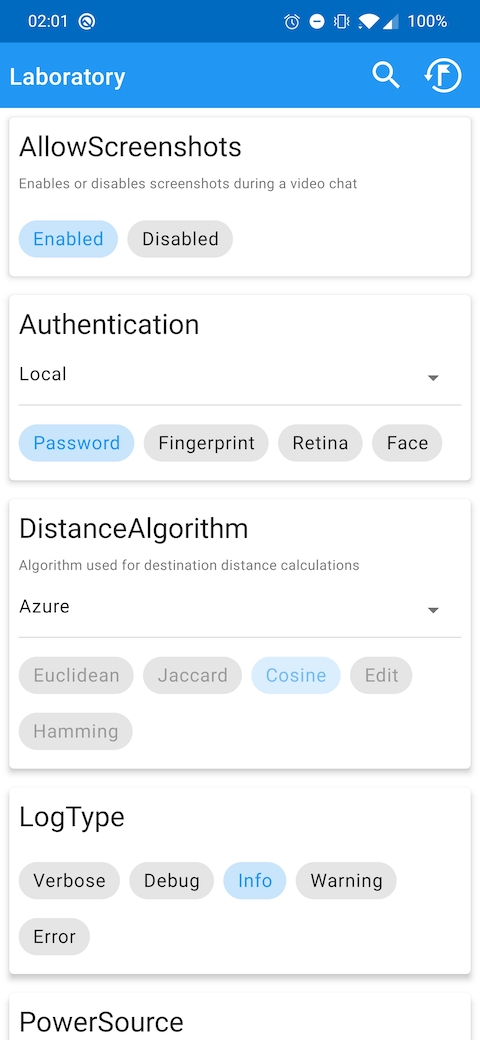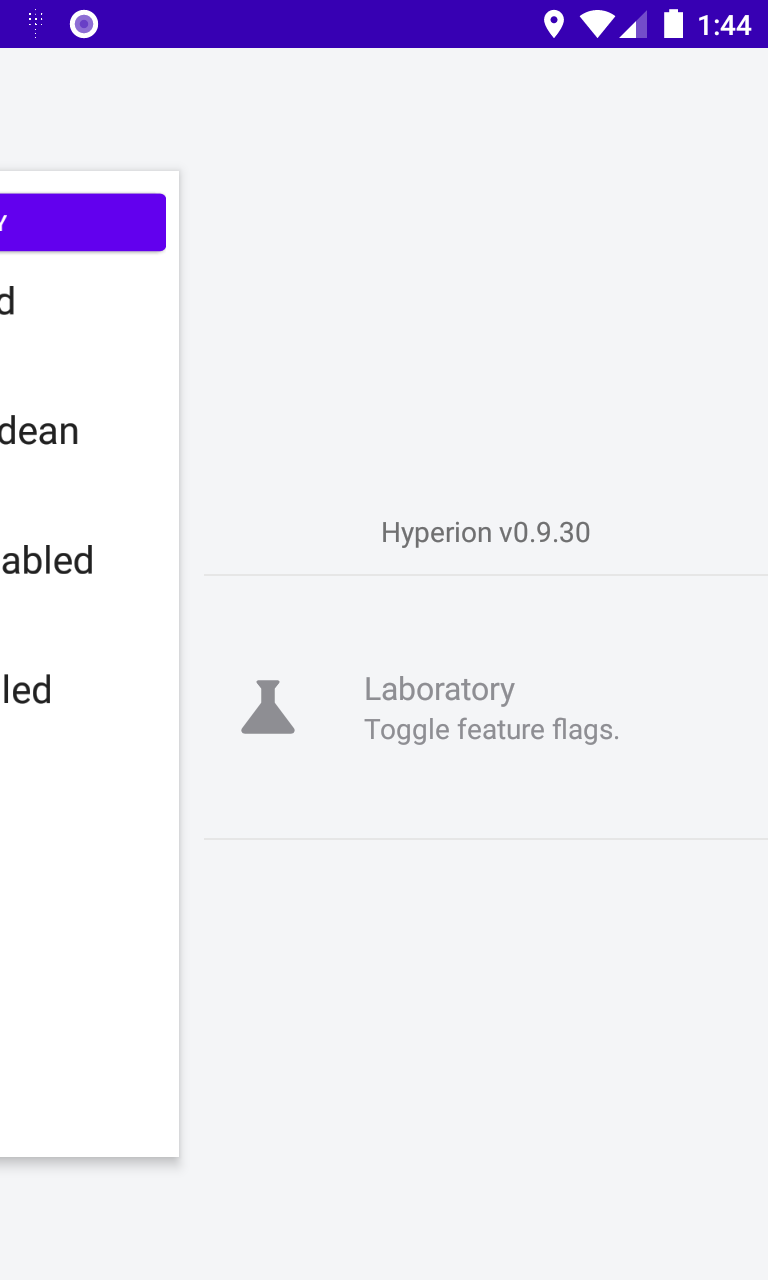QA module¶
It is very often desirable to have the option of configuring feature flag options at runtime. Laboratory addresses this problem with its QA modules.
Inspector¶
Feature flags inspection is available through the laboratory-inspector artifact. LaboratoryActivity is an Activity that enables inspection and modifications of feature flags.

Inspector displays feature flags as cards and their options on chips. Active options of feature flags are marked with a highlight color. A local option of a feature flag can be changed by tapping on a chip. Chips that do not use Local sources cannot have their options changed. If a feature flag has multiple sources available, they can be switched from a drop down menu.
Feature flags (including sources) can be reset to their default options with a button in an action bar.
Configuration¶
Before LaboratoryActivity can be started, it has to be configured with an instance of Laboratory and at least one instance of FeatureFactory. FeatureFactory is an interface that should gather feature flags that are logically grouped together. Logical grouping can be different for each application, but in most cases, all feature flags in the project belong to a single unit. Scenarios, when you might want to split feature flags, are for example:
- Feature flags that do not belong to your project and are exposed to you from an external library.
- Abundance of feature flags and a need to increase the readability of the inspector interface by separating feature flags into custom categories.
Tip
A lot of the boilerplate code presented here can be generated with the Gradle plugin. It is highly recommended to rely on the plugin instead of handwriting the code.
val sourcedFeatureStorage = FeatureStorage.sourced(
localSource = FeatureStorage.inMemory(),
remoteSources = mapOf(
"Firebase" to FeatureStorage.inMemory(),
"Aws" to FeatureStorage.inMemory(),
"Azure" to FeatureStorage.inMemory(),
),
)
val laboratory = Laboratory.create(sourcedFeatureStorage)
LaboratoryActivity.configure(
laboratory = laboratory,
featureFactory = CustomFeatureFactory,
)
LaboratoryActivity.start(context)
object CustomFeatureFactory : FeatureFactory {
override fun create(): Set<Class<out Feature<*>>> = setOf(
AllowScreenshots::class.java,
Authentication::class.java,
PowerSource::class.java,
DistanceAlgorithm::class.java,
LogType::class.java,
)
}
enum class AllowScreenshots : Feature<AllowScreenshots> {
Enabled,
Disabled;
public override val defaultOption get() = Disabled
override val description: String = "Enables or disables screenshots during a video chat"
}
enum class Authentication : Feature<Authentication> {
Password,
Fingerprint,
Retina,
Face;
public override val defaultOption get() = Password
override val source = Source::class.java
enum class Source : Feature<Source> {
Local,
Firebase,
Aws;
public override val defaultOption get() = Local
}
}
enum class DistanceAlgorithm : Feature<DistanceAlgorithm> {
Euclidean,
Jaccard,
Cosine,
Edit,
Hamming;
public override val defaultOption get() = Euclidean
@Suppress("UNCHECKED_CAST")
override val source: Class<Feature<*>> = Source::class.java as Class<Feature<*>>
override val description: String = "Algorithm used for destination distance calculations"
enum class Source : Feature<Source> {
Local,
Firebase,
Azure;
public override val defaultOption get() = Azure
}
}
enum class LogType : Feature<LogType> {
Verbose,
Debug,
Info,
Warning,
Error;
public override val defaultOption get() = Info
}
enum class PowerSource : Feature<PowerSource> {
Coal,
Wind,
Solar,
Nuclear,
ColdFusion;
public override val defaultOption get() = Solar
@Suppress("UNCHECKED_CAST")
override val source: Class<Feature<*>> = Source::class.java as Class<Feature<*>>
enum class Source : Feature<Source> {
Local,
Firebase;
public override val defaultOption get() = Firebase
}
}
Deprecation¶
You can configure how deprecated feature flags will be represented in the QA module. To do this you need to pass additional parameters to the Configuration builder.
val configuration = LaboratoryActivity.Configuration.builder()
.laboratory(laboratory)
.featureFactories(mapOf("Features" to featureFactory))
.deprecationPhenotypeSelector { deprecationLevel -> DeprecationPhenotype.Strikethrough }
.deprecationAlignmentSelector { deprecationLevel -> DeprecationAlignment.Bottom }
.build()
LaboratoryActivity.configure(configuration)
Hyperion¶
If you use Hyperion you can easily integrate Laboratory by adding the laboratory-hyperion-plugin artifact to your dependencies. This will put an item in Hyperion’s debug menu.

If you’d like to position the Laboratory menu item in a different place on the menu, you can override the string id resource.
<?xml version="1.0" encoding="utf-8"?>
<resources>
<string name="io_mehow_laboratory_plugin_id" translatable="false">!Laboratory</string>
</resources>